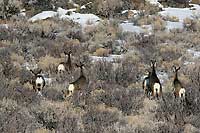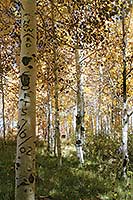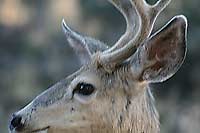Fall is a transitional season, marked by wildlife migrations and transitions. At higher elevations, yellow-bellied marmots and golden-mantled ground squirrels have crawled into their respective winter dens getting ready to sleep the winter away. American pikas, the little “whistling hares” that inhabit rocky talus slopes, are still busy gathering greens into haystacks that will keep them sustained during their winter activity. Migratory birds such as warblers, vireos, hummingbirds and some birds of prey, are winging their way south, some to stop north of the border, others to continue into Latin and Central America.
Larger mammals such as mule deer and elk will move down slope as fall and winter snows start to accumulate. These animals are more elevational migrants than north-south travelers, but they can cover some distance from the mountains down into the sagebrush steppe.
But during the month of October, the mountains offer excellent opportunities to see these large animals on the move. Of course, there’s the aspen turning golden that also shouldn’t be missed as these deer and elk follow their historic patterns and move out of the mountains.
 Mule deer don’t do as well in deeper snows that elk can still pass through, so they move down in elevation into the sagebrush dominated shrublands. They switch from herbaceous plants to woody plants and rely on sagebrush and blackbrush as winter forage. They can’t survive on just woody forage, so these “mulies” search out grasses and forbs that are uncovered by snow. This winter range habitat is critical for the deer to survive.
Mule deer don’t do as well in deeper snows that elk can still pass through, so they move down in elevation into the sagebrush dominated shrublands. They switch from herbaceous plants to woody plants and rely on sagebrush and blackbrush as winter forage. They can’t survive on just woody forage, so these “mulies” search out grasses and forbs that are uncovered by snow. This winter range habitat is critical for the deer to survive.
Following the deer herds that descend from the mountains are predators such as mountain lions and scavengers such as ravens, coyotes and magpies. The lions thin the herds while the scavengers clean up the kills. Both predator and prey are necessary for these herds to remain healthy, and managing that balance is a task of the Utah Division of Wildlife Resources and other agencies.
Elk, on the other hand, may move down into the oak woodlands on the east side of the La Sals. These majestic animals are the second largest cervid in the U.S. - only moose are larger in size. Bull elk can weigh up to 1,000 pounds and females average around 500 pounds.
Elk are often referred to as “wapiti,” a Shawnee Indian word meaning “white rump.” Like many ungulates, elk have white rump hairs that enlarge and act as a visual warning sign to other members of the herd. Pronghorn also use their white rump hairs to warn others of danger.
A real treat for mountain hikers (Wear orange in mountains in October) is to hear elk bugling in the fall and a sign that the rut is on. The males or bulls bugle to challenge other bulls or to communicate with the females. The call starts as a loud bellow, and then changes to a loud whistle before ending in a series of grunts. The bulls may engage in more heated activity than just bugling – they might spar with their antlers, toss plants onto their backs that they’ve peed on, and wallowing in the mud and water. Guess boys will be boys.
Enjoy the mountains and migrations, and get a sense of what October means in Canyon Country.


 Mule deer don’t do as well in deeper snows that elk can still pass through, so they move down in elevation into the sagebrush dominated shrublands. They switch from herbaceous plants to woody plants and rely on sagebrush and blackbrush as winter forage. They can’t survive on just woody forage, so these “mulies” search out grasses and forbs that are uncovered by snow. This winter range habitat is critical for the deer to survive.
Mule deer don’t do as well in deeper snows that elk can still pass through, so they move down in elevation into the sagebrush dominated shrublands. They switch from herbaceous plants to woody plants and rely on sagebrush and blackbrush as winter forage. They can’t survive on just woody forage, so these “mulies” search out grasses and forbs that are uncovered by snow. This winter range habitat is critical for the deer to survive. 